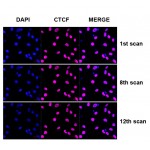| Detection range: | 0.156-10ng/mL |
| Sensitivity: | 0.051ng/mL |
| Type: | Traditional Pgp ELISA kit |
| Synonyms: | CD243; ABCB1; ABC20; CLCS; GP170; MDR1; PGY1; P-Glycoprotein; Multidrug resistance protein 1; ATP-Binding Cassette,Sub-Family B(MDR/TAP),Member 1; Colchicin Sensitivity |
| Species: | Mouse |
| Sample type: | tissue homogenates, cell lysates or other biological fluids. |
| Experimental method: | Sandwich |
| Shelf life: | 12 months |
| Gene ID: | 5243/18669 |
| UniProt ID: | P06795 |
| Components: | 1. Pre-coated, ready to use 96-well strip plate 1 2. Plate sealer for 96 wells 2 3. Standard 2 4. Diluents buffer: 1×45 mL 5. Detection Reagent A: 1×120 μL 6. Detection Reagent B: 1×120 μL 7. TMB Substrate: 1×9 mL 8. Stop Solution: 1×6 mL 9. Wash Buffer (30× concentrate): 1×20 mL |
| Documents: | Manual-Mouse Pgp ELISA Kit |
Background
The membrane-associated protein encoded by this gene is a member of the superfamily of ATP-binding cassette (ABC) transporters. ABC proteins transport various molecules across extra- and intra-cellular membranes. ABC genes are divided into seven distinct subfamilies (ABC1, MDR/TAP, MRP, ALD, OABP, GCN20, White). This protein is a member of the MDR/TAP subfamily. Members of the MDR/TAP subfamily are involved in multidrug resistance. This gene encodes a membrane glycoprotein which confers a multidrug-resistance phenotype. The protein encoded by the human gene is an ATP-dependent drug efflux pump for xenobiotic compounds which is responsible for decreased drug accumulation in multidrug-resistant cells and mediates the development of resistance to anticancer drugs.
Images
| Typical Standard Curve for Mouse Pgp ELISA |
Test principle
The membrane-associated protein encoded by this gene is a member of the superfamily of ATP-binding cassette (ABC) transporters. ABC proteins transport various molecules across extra- and intra-cellular membranes. ABC genes are divided into seven distinct subfamilies (ABC1, MDR/TAP, MRP, ALD, OABP, GCN20, White). This protein is a member of the MDR/TAP subfamily. Members of the MDR/TAP subfamily are involved in multidrug resistance. This gene encodes a membrane glycoprotein which confers a multidrug-resistance phenotype. The protein encoded by the human gene is an ATP-dependent drug efflux pump for xenobiotic compounds which is responsible for decreased drug accumulation in multidrug-resistant cells and mediates the development of resistance to anticancer drugs.
Recovery
Matrices listed below were spiked with certain level of recombinant antigen and the recovery rates were calculated by comparing the measured value to the expected amount of the antigen in samples.
| Matrix | Recovery range (%) | Average(%) |
| serum (n=5) | 80-102 | 91 |
| EDTA plasma(n=5) | 81-100 | 90 |
| heparin plasma(n=5) | 80-89 | 84 |
Linearity
The linearity of the kit was assayed by testing samples spiked with appropriate concentration of the antigen and their serial dilutions. The results were demonstrated by the percentage of calculated concentration to the expected.
| Sample | 1:2 | 1:4 | 1:8 | 1:16 |
| serum(n=5) | 87-91% | 87-107% | 74-101% | 92-97% |
| EDTA plasma(n=5) | 90-105% | 84-101% | 90-101% | 79-108% |
| heparin plasma(n=5) | 84-95% | 92-105% | 82-105% | 89-91% |
Precision
Intra-assay Precision (Precision within an assay): 3 samples with low, middle and high level antigen were tested 20 times on one plate, respectively.
Inter-assay Precision (Precision between assays): 3 samples with low, middle and high level antigen were tested on 3 different plates, 8 replicates in each plate.
CV(%) = SD/meanX100
Intra-Assay: CV<10%Inter-Assay: CV<12%
Stability
The stability of ELISA kit is determined by the loss rate of activity. The loss rate of this kit is less than 5% within the expiration date under appropriate storage condition.
Note: To minimize unnecessary influences on the performance, operation procedures and lab conditions, especially room temperature, air humidity, and incubator temperatures should be strictly regulated. It is also strongly suggested that the whole assay is performed by the same experimenter from the beginning to the end.
Assay procedure summary
1. Prepare all reagents, samples and standards;
2. Add 50µL standard or sample to each well. And then add 50µL prepared Detection Reagent A immediately. Shake and mix. Incubate 1 hour at 37°C;
3. Aspirate and wash 3 times;
4. Add 100µL prepared Detection Reagent B. Incubate 1 hour at 37°C;
5. Aspirate and wash 5 times;
6. Add 90µL Substrate Solution. Incubate 15-25 minutes at 37°C;
7. Add 50µL Stop Solution. Read at 450 nm immediately.


